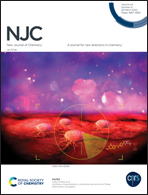DNA-mediated biomineralization of calcium-deficient hydroxyapatite for bone tissue engineering†
Abstract
Biomineralization offers an effective route to incorporate biomolecules into osteoconductive calcium-deficient hydroxyapatite (CdHAp) for bone tissue engineering. However, the template biomolecules for CdHAp biomineralization are limited to peptides and polysaccharides. Herein, we investigate the potential of DNA molecules as biotemplates for mediating the biomineralization of CdHAp. As a demonstration, a random DNA duplex was utilized as the model. The DNA template can manipulate the growth and morphology of the CdHAp mineral upon incorporation into the mineral to obtain a DNA-incorporated CdHAp (DNA@CdHAp) composite. Compared with pure CdHAp, the DNA@CdHAp composite exhibited unique hierarchical features consisting of spherical clusters under the mediation of DNA. Moreover, the DNA@CdHAp composite showed better biocompatibility in terms of cell viability, proliferation and attachment by evaluating the behaviors of human mesenchymal stem cells (hMSCs) cultured on mineral substrates. After culturing the hMSCs on the composite for 3 days, the osteogenic marker genes including alkaline phosphatase (ALP) mRNA and osteocalcin (OCN) mRNA were significantly upregulated, indicating the superior osteoconductive properties of the DNA@CdHAp composite. In general, the DNA-mediated CdHAp biomineralization can promote cell proliferation and differentiation and thus has great potential in bone tissue engineering.



 Please wait while we load your content...
Please wait while we load your content...